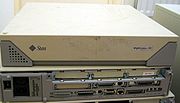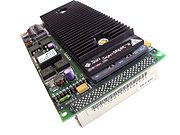
SPARCstation 20
Encyclopedia

Sun Microsystems
Sun Microsystems, Inc. was a company that sold :computers, computer components, :computer software, and :information technology services. Sun was founded on February 24, 1982...
workstation
Workstation
A workstation is a high-end microcomputer designed for technical or scientific applications. Intended primarily to be used by one person at a time, they are commonly connected to a local area network and run multi-user operating systems...
based on the SuperSPARC
SPARC
SPARC is a RISC instruction set architecture developed by Sun Microsystems and introduced in mid-1987....
or hyperSPARC
HyperSPARC
The hyperSPARC, code-named "Pinnacle", is a microprocessor that implements the SPARC Version 8 instruction set architecture developed by Ross Technology for Cypress Semiconductor....
CPU. It was the last model in the SPARCstation
SPARCstation
The SPARCstation, SPARCserver and SPARCcenter product lines were a series of SPARC-based computer workstations and servers in desktop, deskside and rack-based form factor developed and sold by Sun Microsystems...
family of Sun "pizza box
Pizza box form factor
In computing, a pizza box is a style of case for computers or network switches. Cases of this type tend to be wide and flat, normally one or two rack units in height, thus resembling pizza delivery boxes....
" computers, which was superseded by the UltraSPARC
Sun Ultra series
The original Sun Ultra series was a series of UltraSPARC-based workstations and servers developed and sold by Sun Microsystems from 1995 to 2001...
design in 1995.
CPU support

SPARCstation 10
The SPARCstation 10 is a workstation computer made by Sun Microsystems. Announced in May 1992, it was Sun's first desktop multiprocessor...
. With two dual-CPU modules and updated firmware
Firmware
In electronic systems and computing, firmware is a term often used to denote the fixed, usually rather small, programs and/or data structures that internally control various electronic devices...
, the SPARCstation 20 supported a maximum of 4 CPUs. The fastest CPU produced for the SPARCstation 20 was the 200 MHz Ross
Ross Technology, Inc.
Ross Technology, Inc. was a semiconductor design and manufacturing company, specializing in SPARC microprocessors. It was founded in Austin, Texas in August 1988 by Dr. Roger D. Ross, a leading computer scientist who headed Motorola's Advanced Microprocessor Division and directed the developments...
hyperSPARC.
The PROM
PROM
PROM may refer to:*Phosphate rich organic manure*Premature rupture of membranes, an obstetric term*PROM-1 land mine*Programmable read-only memory, related to electronics...
in the SPARCstation 20 determines CPU compatibility. Version 2.25r was the last PROM release for the SPARCstation 20.
Memory
The SPARCstation 20 has 8 200-pin DSIMM slots, and supports a maximum of 512 MB of memory with 64 MB modules. Memory modules for the SPARCstation 20 are compatible with the SPARCstation 10SPARCstation 10
The SPARCstation 10 is a workstation computer made by Sun Microsystems. Announced in May 1992, it was Sun's first desktop multiprocessor...
, Sun Ultra 1, and other computers in the sun4m and Sun4d
Sun4d
Sun4d is a computer architecture introduced bySun Microsystems in 1992. It is a development of the earlier Sun-4 architecture, using the XDBus system bus,SuperSPARC processors, and SBus I/O cards. The XDBuswas the result of a collaboration between Sun...
family, but they are physically incompatible with the SIMM slots found in PC computers
IBM PC compatible
IBM PC compatible computers are those generally similar to the original IBM PC, XT, and AT. Such computers used to be referred to as PC clones, or IBM clones since they almost exactly duplicated all the significant features of the PC architecture, facilitated by various manufacturers' ability to...
.
2 of the 8 SIMM slots are wider than the others and can be used with non-memory peripherals like caching NVSIMM and video VSIMM cards.
Disk drives

Single Connector Attachment
Single Connector Attachment, or SCA, is a type of connection for the internal cabling of SCSI systems. There are two versions of this connector: the SCA-1, which is deprecated, and SCA-2, which is currently in use in most systems...
bays, an external SCSI connector, and two bays for CD-ROM
CD-ROM
A CD-ROM is a pre-pressed compact disc that contains data accessible to, but not writable by, a computer for data storage and music playback. The 1985 “Yellow Book” standard developed by Sony and Philips adapted the format to hold any form of binary data....
or floppy drives. The CD-ROM and floppy bays are slightly shorter than a standard 3.5" bay and regular devices intended for PC compatible computers do not usually fit.
The SCSI
SCSI
Small Computer System Interface is a set of standards for physically connecting and transferring data between computers and peripheral devices. The SCSI standards define commands, protocols, and electrical and optical interfaces. SCSI is most commonly used for hard disks and tape drives, but it...
host controller is integrated with the motherboard. The SPARCstation 20 does not support IDE devices.
A limitation in all releases of the OpenBoot PROM
PROM
PROM may refer to:*Phosphate rich organic manure*Premature rupture of membranes, an obstetric term*PROM-1 land mine*Programmable read-only memory, related to electronics...
for the SPARCstation 20 prevents it from booting from a filesystem larger than 2 gigabytes.
Network
The SPARCstation 20 has one integrated AMD Lance 10baseT EthernetEthernet
Ethernet is a family of computer networking technologies for local area networks commercially introduced in 1980. Standardized in IEEE 802.3, Ethernet has largely replaced competing wired LAN technologies....
interface. Additional Ethernet interfaces can be added with an SBus
SBus
SBus is a computer bus system that was used in most SPARC-based computers from Sun Microsystems and others during the 1990s...
card.
Graphics
The SPARCstation 20 has a built in 13W3DB13W3
DB13W3 is a particular style of D-subminiature connector commonly used as an analog video interface connector that was used primarily on Sun Microsystems, Silicon Graphics and IBM RISC workstations, as well as some displays from Apple Computer, NeXT Computer and Intergraph Corporation...
video socket driven by an optional SX (CG14) framebuffer
Framebuffer
A framebuffer is a video output device that drives a video display from a memory buffer containing a complete frame of data.The information in the memory buffer typically consists of color values for every pixel on the screen...
built onto a VSIMM. The VSIMM is available in 4MB or 8MB capacity, capable of up to 1280x1024 (8MB) or 1152x900 (4MB) in 24-bit color. If two VSIMMs are installed an auxiliary video board must also be installed to provide a second 13W3 video socket. Alternatively, SBus cards can be used, including the ZX (Leo), Turbo GX (CG6) and others.
Sound
The SPARCstation 20 has integrated sound with 4 standard 3.5 mm audio jacks for headphones, microphone, line in, and line out.NVRAM
The SPARCstation 20 uses NVRAM to hold data about the system, such as the serial number and MAC addressMAC address
A Media Access Control address is a unique identifier assigned to network interfaces for communications on the physical network segment. MAC addresses are used for numerous network technologies and most IEEE 802 network technologies, including Ethernet...
. If the battery on the chip dies, then the NVRAM must be reset.
Operating systems
SunOSSunOS
SunOS is a version of the Unix operating system developed by Sun Microsystems for their workstation and server computer systems. The SunOS name is usually only used to refer to versions 1.0 to 4.1.4 of SunOS...
4.1.3_U1B onwards, Solaris
Solaris Operating System
Solaris is a Unix operating system originally developed by Sun Microsystems. It superseded their earlier SunOS in 1993. Oracle Solaris, as it is now known, has been owned by Oracle Corporation since Oracle's acquisition of Sun in January 2010....
2.3 to 9, Linux (Debian, Gentoo, SuSE 7.0 - 7.3, probably others), MirBSD, NetBSD
NetBSD
NetBSD is a freely available open source version of the Berkeley Software Distribution Unix operating system. It was the second open source BSD descendant to be formally released, after 386BSD, and continues to be actively developed. The NetBSD project is primarily focused on high quality design,...
and OpenBSD
OpenBSD
OpenBSD is a Unix-like computer operating system descended from Berkeley Software Distribution , a Unix derivative developed at the University of California, Berkeley. It was forked from NetBSD by project leader Theo de Raadt in late 1995...
run on the SPARCstation 20. On certain CPU modules (Sun SuperSPARC only), NeXTSTEP
NEXTSTEP
NeXTSTEP was the object-oriented, multitasking operating system developed by NeXT Computer to run on its range of proprietary workstation computers, such as the NeXTcube...
3.3 and OPENSTEP
OpenStep
OpenStep was an object-oriented application programming interface specification for an object-oriented operating system that used a non-NeXTSTEP operating system as its core, principally developed by NeXT with Sun Microsystems. OPENSTEP was a specific implementation of the OpenStep API developed...
4.x also run.
External links
- OSIAH SPARCstation 20 Specifications
- FAQABOSS for old Sun computers
- The Rough Guide to MBus Modules (A list of CPU modules for the SPARCstation 20.)

